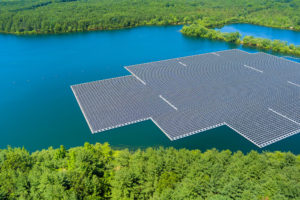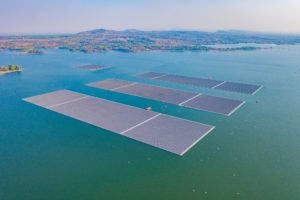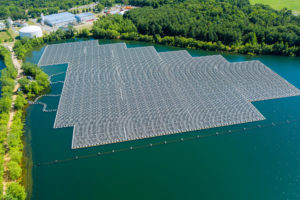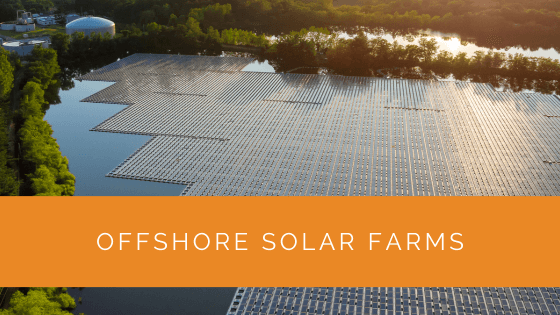In the ever-evolving landscape of renewable energy, offshore solar farms have emerged as a compelling and innovative solution to meet the world’s increasing demand for clean and sustainable power. These floating solar installations represent a remarkable convergence of technology, environmental consciousness, and the pursuit of a greener future. In this comprehensive article, we will dive deep into the world of offshore solar farms, exploring the intricacies of their technology, the multifaceted benefits they offer, their role in the broader context of renewable energy, and the promising future they hold.
Contents
- 1 Key Takeaways
- 2 Harnessing the Power of the Ocean
- 3 Advancing Renewable Energy
- 4 Solar Power on the Horizon
- 5 Case Study: Implementing an Offshore Solar Farm
- 6 Expert Insights From Our Solar Panel Installers About Offshore Solar Farms
- 7 Experience Solar Excellence with Us!
- 8 Conclusion
Key Takeaways
- Using floating solar technology, offshore solar farms offer a groundbreaking solution to harness solar energy from water bodies, providing space-efficient and efficient renewable energy.
- The synergy between offshore solar and wind power enhances reliability and sustainability in renewable energy production.
- The future of offshore solar farms is bright, with emerging technologies, international adoption, and a commitment to addressing challenges, contributing to a greener and more sustainable energy landscape.
Harnessing the Power of the Ocean
Understanding Offshore Solar Farms
Offshore solar farms, often called solar power plants on water, are expansive photovoltaic systems strategically situated atop bodies of water, ranging from tranquil lakes and reservoirs to the vast and dynamic expanse of the open sea. The fundamental principle behind these innovative solar farms is straightforward yet groundbreaking: they employ solar panels securely mounted on buoyant platforms, allowing them to float on the water’s surface gracefully. This ingenious approach harnesses the sun’s radiant energy in an environment previously untapped for large-scale energy generation.
Key Components of Offshore Solar Farms
To grasp the intricacies of offshore solar farms, it’s essential to delve into their key components:
- Floating Solar Panels: These specialized panels, designed for buoyancy and durability, are the workhorses of offshore solar farms, responsible for capturing sunlight and converting it into electricity.
- Anchoring Systems: Robust anchoring systems are integral to ensuring the stability and secure placement of the floating platforms. They must withstand the forces of wind, waves, and currents.
- Electrical Infrastructure: An efficient electrical network ensures the seamless transmission of the electricity generated by the solar panels to the grid, where it can power homes, businesses, and industries.
Benefits of Offshore Solar
The advantages of offshore solar farms extend beyond their captivating visuals on the water’s surface. They offer a multitude of benefits:
- Space Efficiency: Unlike traditional onshore solar farms, offshore installations optimize space, freeing up land for other essential purposes.
- Enhanced Efficiency: The proximity to water results in a cooling effect on the solar panels, which, in turn, enhances their efficiency and energy production.
- Water Conservation: In cases where offshore solar farms are established on reservoirs, they can serve as a barrier against water evaporation, contributing to preserving this valuable resource.

Floating Solar Technology
At the heart of offshore solar farms lies the innovative technology of floating solar panels, commonly known as floatovoltaics. These panels are meticulously engineered to withstand the unique challenges posed by their aquatic environment while efficiently capturing sunlight to generate clean electricity.
Advantages and Innovations
Floating solar panels bring a wealth of advantages to the table:
- Reduced Land Footprint: Using water bodies often underutilized, floating solar technology minimizes the need for land-based installations, making it ideal for densely populated regions.
- Enhanced Panel Performance: The cooling effect of the water beneath the panels prolongs their lifespan and significantly boosts their efficiency, resulting in higher energy yields.
- Environmental Benefits: In certain scenarios, such as reservoir installations, the shade cast by floating panels can inhibit algae growth and help maintain water quality.
- Water Evaporation Control: Floating solar panels can protect against water evaporation, especially in reservoirs, contributing to water conservation efforts.
Applications and Real-world Examples
Around the globe, governments, corporations, and organizations have enthusiastically embraced floating solar technology, ushering in a new era of clean energy production.
- Singapore’s Tengeh Reservoir: The Tengeh Reservoir in Singapore is home to one of the world’s largest floating solar farms, providing renewable electricity to thousands of households.
- Global Adoption: Nations like Japan and China have incorporated floating solar installations as significant components of their renewable energy portfolios, underscoring their potential on a global scale.
Offshore Wind and Solar Synergy
One of the most compelling aspects of offshore solar farms is their compatibility with offshore wind energy, which results in a dynamic synergy capable of revolutionizing renewable energy production.
The Complementary Nature
Solar panels are most productive during the daytime when wind speeds are lower. Conversely, wind turbines generate more electricity during higher wind speeds and at night. This complementary relationship ensures a steady and dependable energy supply.
Synergy Projects and Success Stories
The Karmøy Hybrid Park in Norway exemplifies the harmonious synergy between offshore solar and wind. This pioneering endeavor combines floating solar panels with wind turbines, maximizing energy output and bolstering grid stability. Projects like these serve as inspirations for the future of renewable energy integration.

Advancing Renewable Energy
The Energy Transition
The global shift towards clean and renewable energy sources often called the energy transition, is at the forefront of the fight against climate change and pursuing a sustainable future.
A Global Shift Towards Clean Energy
Countries across the globe are committing to ambitious renewable energy targets, aiming to reduce carbon emissions, diminish reliance on fossil fuels, and ensure a greener and more sustainable tomorrow.
Offshore Solar’s Contribution
Offshore solar farms play a pivotal role in advancing the energy transition goals. By harnessing the sun’s energy from vast water bodies, they provide a substantial source of clean electricity.
Offshore Solar Across the Globe
The adoption of offshore solar technology is gaining momentum across nations, with numerous international projects and initiatives taking shape.
Pioneering Countries in Offshore Solar
Countries like the Netherlands, Japan, and South Korea have emerged as pioneers in offshore solar technology. Their commitment to innovation and sustainability has led to groundbreaking developments.
Lessons and Insights
These pioneering projects offer invaluable lessons and insights into the deployment of offshore solar technology. As knowledge accumulates, advancements refine offshore solar farms’ technology and deployment strategies.
Solar Power on the Horizon
Photovoltaic Technology
At the core of offshore solar farms lies photovoltaic technology, directly converting sunlight into electricity. This foundational technology continues to evolve and improve.
Advancements in Photovoltaics
Ongoing research and development efforts focus on enhancing photovoltaic cells’ efficiency, durability, and sustainability. Innovations in materials and manufacturing processes aim to push the boundaries of solar power generation.
Sustainable and Efficient Solutions
In the quest for sustainability, efforts are being made to minimize the environmental impact of offshore solar farms. This includes recycling initiatives and responsible disposal practices to ensure the long-term viability of these installations.

The Future of Offshore Solar Farms
The journey into offshore solar farms is only just beginning. As technology evolves and research progresses, the possibilities for harnessing clean energy from our oceans expand.
Emerging Trends and Technologies
Emerging trends encompass various aspects, from improved floating platform designs to novel solar panel materials. The future promises even more efficient and sustainable offshore solar installations.
Potential Challenges and Solutions
Challenges such as maintenance in harsh marine environments, environmental impact mitigation, and adapting to extreme weather conditions must be addressed to ensure offshore solar projects’ long-term success and resilience.
Case Study: Implementing an Offshore Solar Farm
Background
A renewable energy company sought to develop an offshore solar farm to harness solar energy from a large reservoir. The goal was to provide a sustainable energy source without using land space, thus optimizing resource utilization and contributing to the local grid’s clean energy supply.
Project Overview
The project involved the installation of a 20 MW offshore solar farm, designed to float on a reservoir. This initiative aimed to capitalize on the benefits of floating solar technology, including enhanced panel efficiency due to water cooling and reduced land use.
Implementation
Site Assessment and Planning: The initial phase involved a thorough site assessment to determine the reservoir’s suitability for a floating solar farm. Factors considered included water depth, solar irradiance, and potential shading from nearby structures. The assessment confirmed that the site had high solar potential and minimal shading, making it ideal for the project.
Design and Engineering: The design phase focused on creating a robust and efficient floating structure. The solar panels were mounted on buoyant platforms designed to withstand water movement and weather conditions. A reliable anchoring system was implemented to ensure stability, using durable materials that could endure the aquatic environment.
Installation: The installation process was conducted in phases. Initially, the anchoring systems were deployed to secure the floating platforms. Subsequently, solar panels were mounted on these platforms. The electrical infrastructure, including inverters and transformers, was installed to facilitate efficient energy transmission to the grid. The entire installation took approximately three months, with continuous monitoring to ensure all components were correctly positioned and functioning.
Integration with Existing Systems: The new offshore solar farm was integrated with the existing grid infrastructure. This involved setting up connections to the local substation and configuring the system to optimize energy flow. Advanced monitoring systems were installed to track performance in real-time, allowing for quick identification and resolution of any issues.
Results
The offshore solar farm began operations smoothly, generating an estimated 30 million kilowatt-hours (kWh) annually. This output was sufficient to power approximately 5,000 homes, significantly contributing to the local renewable energy supply. The cooling effect of the water improved the panels’ efficiency by about 15%, ensuring higher energy yields compared to land-based solar installations.
The project also demonstrated environmental benefits. By reducing land usage, the solar farm preserved natural landscapes and avoided potential disruptions to terrestrial ecosystems. Additionally, the floating panels helped reduce water evaporation from the reservoir, contributing to water conservation efforts.
Summary
This case study illustrates the successful implementation of an offshore solar farm, showcasing the potential of floating solar technology in renewable energy production. The project highlighted the efficiency gains from water cooling, the benefits of preserving land, and the contribution to sustainable energy goals. By leveraging innovative design and robust engineering, the offshore solar farm delivered substantial clean energy to the grid, setting a precedent for future renewable energy projects.
Expert Insights From Our Solar Panel Installers About Offshore Solar Farms
Offshore solar farms are an exciting frontier in renewable energy. By utilizing water bodies, these installations can produce clean energy without occupying valuable land space, which is a significant advantage for densely populated areas.
The cooling effect of water on solar panels in offshore solar farms significantly enhances their efficiency. This natural cooling mechanism helps in maintaining optimal performance and prolonging the lifespan of the panels.
Integrating offshore solar with wind power creates a robust and reliable renewable energy system. This synergy allows for continuous energy production, maximizing the potential of both solar and wind resources.
Experience Solar Excellence with Us!
Trust in Solar Panels Network USA, where our seasoned experts deliver top-quality solar solutions for homes and businesses nationwide. With a legacy of countless successful installations and a commitment to sustainable energy, we’re your reliable partner in the solar journey. Ready for a brighter, eco-friendly future? Call us now at (855) 427-0058 and harness the power of the sun!
Conclusion
Offshore solar farms represent a remarkable leap forward in renewable energy. These floating solar installations, often accompanied by wind turbines, offer ingenious solutions to the world’s ever-growing energy needs. As nations and organizations worldwide embrace offshore solar technology, we draw closer to a future where clean, sustainable electricity is accessible to all. The oceans of energy are boundless, and offshore solar farms are helping us tap into this incredible resource, paving the way for a brighter, greener, and more electrifying tomorrow. Embrace the power of the sun, wind, and water – a journey worth taking for a sustainable, renewable, and electrifying future.
About the Author
Solar Panels Network USA stands at the forefront of solar energy solutions, driven by a team of seasoned solar engineers and energy consultants. With over decades of experience in delivering high-quality solar installations and maintenance, we are committed to promoting sustainable energy through customer-centric, tailored solutions. Our articles reflect this commitment, crafted collaboratively by experts to provide accurate, up-to-date insights into solar technology, ensuring our readers are well-informed and empowered in their solar energy decisions.

